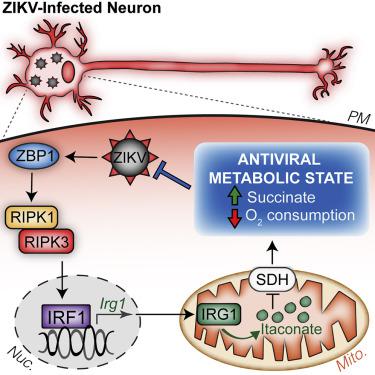Our official English website, www.x-mol.net, welcomes your
feedback! (Note: you will need to create a separate account there.)
The Nucleotide Sensor ZBP1 and Kinase RIPK3 Induce the Enzyme IRG1 to Promote an Antiviral Metabolic State in Neurons.
Immunity ( IF 25.5 ) Pub Date : 2019-01-08 , DOI: 10.1016/j.immuni.2018.11.017
Brian P Daniels 1 , Sigal B Kofman 1 , Julian R Smith 1 , Geoffrey T Norris 1 , Annelise G Snyder 1 , Joseph P Kolb 2 , Xia Gao 3 , Jason W Locasale 3 , Jennifer Martinez 2 , Michael Gale 4 , Yueh-Ming Loo 4 , Andrew Oberst 4
Immunity ( IF 25.5 ) Pub Date : 2019-01-08 , DOI: 10.1016/j.immuni.2018.11.017
Brian P Daniels 1 , Sigal B Kofman 1 , Julian R Smith 1 , Geoffrey T Norris 1 , Annelise G Snyder 1 , Joseph P Kolb 2 , Xia Gao 3 , Jason W Locasale 3 , Jennifer Martinez 2 , Michael Gale 4 , Yueh-Ming Loo 4 , Andrew Oberst 4
Affiliation

|
As long-lived post-mitotic cells, neurons employ unique strategies to resist pathogen infection while preserving cellular function. Here, using a murine model of Zika virus (ZIKV) infection, we identified an innate immune pathway that restricts ZIKV replication in neurons and is required for survival upon ZIKV infection of the central nervous system (CNS). We found that neuronal ZIKV infection activated the nucleotide sensor ZBP1 and the kinases RIPK1 and RIPK3, core components of virus-induced necroptotic cell death signaling. However, activation of this pathway in ZIKV-infected neurons did not induce cell death. Rather, RIPK signaling restricted viral replication by altering cellular metabolism via upregulation of the enzyme IRG1 and production of the metabolite itaconate. Itaconate inhibited the activity of succinate dehydrogenase, generating a metabolic state in neurons that suppresses replication of viral genomes. These findings demonstrate an immunometabolic mechanism of viral restriction during neuroinvasive infection.
中文翻译:

核苷酸传感器 ZBP1 和激酶 RIPK3 诱导酶 IRG1 以促进神经元中的抗病毒代谢状态。
作为长寿的有丝分裂后细胞,神经元采用独特的策略来抵抗病原体感染,同时保持细胞功能。在这里,我们使用寨卡病毒 (ZIKV) 感染的小鼠模型,确定了一种先天免疫通路,该通路限制了 ZIKV 在神经元中的复制,并且是 ZIKV 感染中枢神经系统 (CNS) 后生存所必需的。我们发现神经元 ZIKV 感染激活了核苷酸传感器 ZBP1 和激酶 RIPK1 和 RIPK3,它们是病毒诱导的坏死性细胞死亡信号传导的核心成分。然而,在 ZIKV 感染的神经元中激活该通路不会诱导细胞死亡。相反,RIPK 信号通过上调 IRG1 酶和产生代谢物衣康酸盐来改变细胞代谢,从而限制病毒复制。衣康酸抑制琥珀酸脱氢酶的活性,在神经元中产生抑制病毒基因组复制的代谢状态。这些发现证明了神经侵袭性感染期间病毒限制的免疫代谢机制。
更新日期:2019-01-08
中文翻译:

核苷酸传感器 ZBP1 和激酶 RIPK3 诱导酶 IRG1 以促进神经元中的抗病毒代谢状态。
作为长寿的有丝分裂后细胞,神经元采用独特的策略来抵抗病原体感染,同时保持细胞功能。在这里,我们使用寨卡病毒 (ZIKV) 感染的小鼠模型,确定了一种先天免疫通路,该通路限制了 ZIKV 在神经元中的复制,并且是 ZIKV 感染中枢神经系统 (CNS) 后生存所必需的。我们发现神经元 ZIKV 感染激活了核苷酸传感器 ZBP1 和激酶 RIPK1 和 RIPK3,它们是病毒诱导的坏死性细胞死亡信号传导的核心成分。然而,在 ZIKV 感染的神经元中激活该通路不会诱导细胞死亡。相反,RIPK 信号通过上调 IRG1 酶和产生代谢物衣康酸盐来改变细胞代谢,从而限制病毒复制。衣康酸抑制琥珀酸脱氢酶的活性,在神经元中产生抑制病毒基因组复制的代谢状态。这些发现证明了神经侵袭性感染期间病毒限制的免疫代谢机制。

































 京公网安备 11010802027423号
京公网安备 11010802027423号